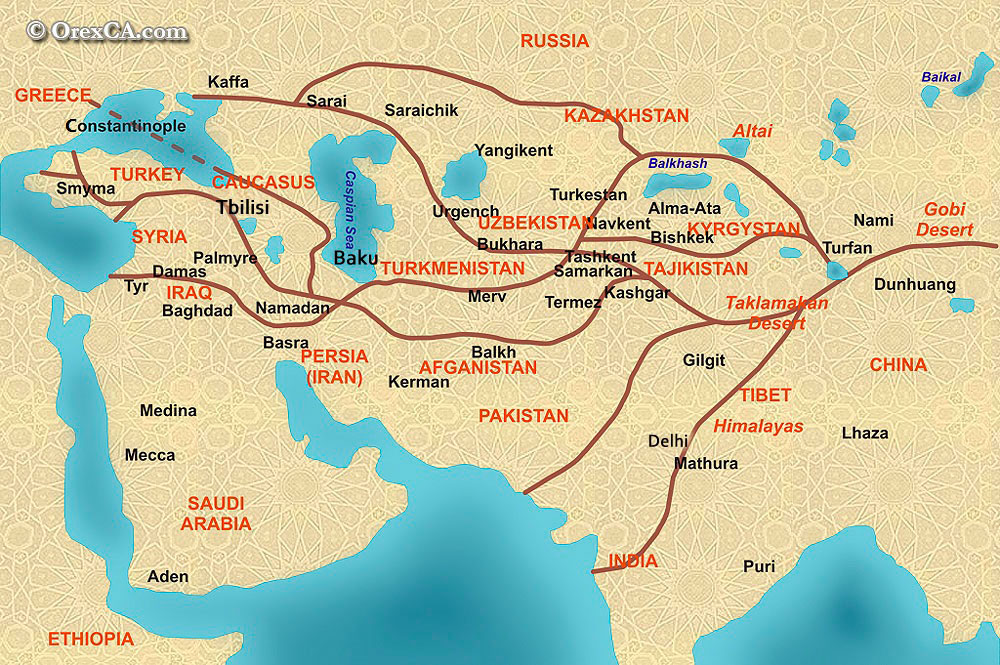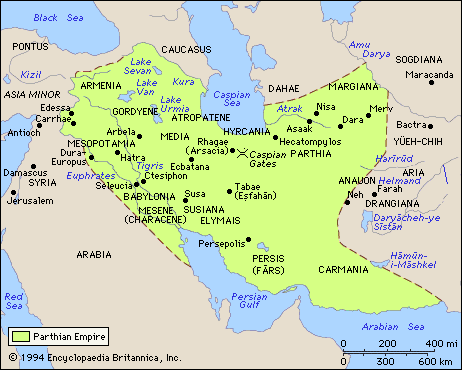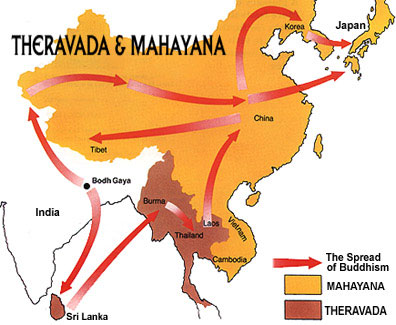I. The Silk Road
A. Origins and Operations
1. Parthians--because the Seleucid kings who succeeded Alexander the Great in the 3rd century BCE focused their energies in Mesopotamia and Syria, an Iranian nomadic leader was able to establish an independent kingdom in northern Iran. The Parthian Kingdom left little in the way of written documents, and constant warfare between themselves and the Greeks and the Romans meant we can gleen little from those source; what we have been able to uncover indicates that they helped forster the Silk Road by being the initial western terminus, and because they shared customs with the nomadic peoples farther east, who also helped establish this trade route.
2. Zhang Jian--travelled west in search of desirable trade goods (particularly horses), which he found with the nomadic people residing in the Valley of Ferghana, where he also encountered for the first time rivers that flowed to the west.
3. Nomadic peoples of the steppes--although little of the trade along the Silk Road was directed toward the local people of the steppes, that trade would not have occurred without their assistance and acquiesence.
4. Trade goods:
a. Silk from China
b. New plants to China--like pistachio, walnuts, pomegranates, sesame, spinach; non-food items like jasmine oil, oak galls, sal ammonia, copper oxides, zinc, and precious stones.
B. Nomadism in Central and Inner Asia--the Silk Road could not function without the guidance these nomadic people provided, along with the animals and animal handlers to transport the trade goods.
1. Scythians--appear in the writings of the Greek historian Herodotus in the 6th century BCE. Extremely proficient on horseback, they moved regularly and effiencently with their huge hers of livestock.
2. Self-sufficiency--because of their mobility, nomads liked to make sure their food source was mobile, as well. Although they ate and used products grown by farmers, they remained nomadic to ensure that their herds did not overgraze.
3. Dependency--nomads were dependent upon settled regions to provide bronze metal and iron, which they then reshaped to use in stirrups, bridles, cart fittings, and weapons.
C. Impact of the Silk Road
1. Iranian speakers--as trade became more important in Central Asia, the Iranian speakers largley moved to trading cities and surrounding farm villages, and were replaced on the steppes by peoples speaking unrelated Turkic languages.
2. Military technology--radiated outward from the nomadic people, who invented technology like the stirrup and the chariot.
II. The Indian Ocean Maritime System
A. Ship Design--ships used in the Indian Ocean differed from those sailing in the west. Whereas ships in the Mediterranean used square sails and oarsmen, Indian Ocean vessels use triangular sails without oarsmen.
1. Greater distances--for merchants and sailors in the Indian Ocean meant that the trade that took place there was fundamentally different than that in the Mediterranean; whereas Greece and Rome established colonies under their direct poltical control, trading colonies in the Indian Ocean were generally ruled by local princes.
B. Origins of Contact and Trade
1. Earliest Records--from around 2000BCE Sumerian records indicate regular trade between Mesopotamia, the islands in the Persian Gulf, Oman, and the Indus Valley. This trade broke off, eventually, and later trade references mention East Africa more often than India.
2. Madagascar--about 2000 years ago, sailors from Southeast Asia crossed the Indian Ocean, eventually settling on the island of Madagascar. They brought with them some of their native foods, like bananas, yams, and other crops native to Southeast Asia, which were promptly introduced to mainland Africa, as well.
B. Impact of Indian Ocean Trade
1. Demand for trade goods
a. East Africa--provided exotic animals, wood, and ivory (irvory was also proved other regions bordering the Indian Ocean, so it is difficult in determining what ivory came from where)
b. Somalia and southern Arabia--grew scrubby trees whose aromatic resin was valued as frankincense and myrrh.
c. The Persian Gult abounded with pearls
d. Oman provide a source of copper
e. India and Southeast Asia--provided spices; Southeast Asia was also a conduit for manufactured items--particularly pottery--from China.
2. Small hinterlands--trade in the Indian Ocean basin was hindered by the small hinterlands of Indian Ocean ports, particularly those ports to the west. This meant they had less access to items to trade with, and also meant the trade volume was less.
3. Greater distances--whereas the Mediterranean was relatively compact, the great distance between ports in the Indian Ocean meant more time travelling, and less time trading.
III. Routes Across the Sahara
A. Early Saharan Cultures
1. Climate change--the Sarhara Desert is the result of significant climate change; before its formation (a gradual process0, people lived in the area it now occupies. As change occurred gradually, people learned to adampt or, mostly, moved on to more hospitable environments.
2. Rock paintings--much of what we know about early life in the Sahara comes from interpreting rock paintings left in the desert, which depict scenes of life there that are remarkably similar to life in the northern reaches of sub-Saharan Africa today--like pastoral cattle raising.
a. Cattle breeders were succeeded by horse breeders, who used the horsed to pull chariots. We are uncertain exactly where these horse breeders came from, although the hypothesis that they were refugees from Mycenean and Minoan civilizations seems highly unlikely.
b. Domestication of the Camel--probably inaugurated trans-Saharan trade, because humans then had a means of reliable transportation across the forbidding landscape.
B. Trade Across the Sahara
1. Southern traders--traders in the southern region of the Sahara utilized the salt deposits there to trade for goods with sub-Saharan peoples, particularly forest products like kola nuts and palm oil.
2. Sahel people--the southern borderlands of the Sahara was populated with farmers who traded grain to both Saharan merchants and the sub-Saharan peoples.
3. Roman colonists--provided Italy with agricultural products, primarily wheat and olives. This pattern changed in the 3rd century CE, with the decline of the western half of the Roman Empire.
IV. Sub-Saharan Africa
A. Challenging Geography--the Sahara, the Atlantic and Indian Oceans, and the Red Sea form the boundaries of the region, and worked to isolate it from from contact with other regions
1. 4000 Miles--the distance from the southern edge of the Sahara to the Cape of Good Hope. A traveler would have to cover over 50 degrees of latitude, and travel through the flat, arid steppes of the Sahel regions, to the tropical savanna, through the tropical rainforest, then through another expanse of savana, followed by more steppe and desert, and then finally a region of temperate highlands at the southern tip--and as far south of the equator as Greece and Sicily are north.
B. Development of Cultural Unity--the geographic isolation enjoyed by sub-Saharan Africa worked more in favor of fostering cultural diversity than cultural unity; there are more than 2000 languages spoken throughout the region.
1. Geographic diversity--fostered diverse food production systems, from hunting and gathering (in diverse locations, from tropical jungle to teh Khosian people of the southwestern deserts, to the cultivation of bananas and yams to sorghum and other grains).
2. Sub-Saharan African covered a larger and more diverse area than any other cultural region in the first millenium CE, and had a lower overall population density. Societies and polities therefore had ample room to form and reform, and ample space separated such groups--therefore, there was not the conflict that fostered cultural succession in much of the rest of the world.
3. Isolation--the geographic barriers also prevented most outside contact, and meant that they were isolated from contact with aggressive cultures like the Greeks and the Romans--but also isolated from their techonology.
C. African Cultural Characteristics--despite all these factors promoting cultural diversity, there were cultural similarities, as well.
1. Agricultural techniques--use of the digging stick and hoe
2. Rhythmic nature of African music--and the use of the drum. Music played an important role in social rituals, and did dancing and the wearing of masks.
3. Ritual isolation of kings and fixed social categories--age groups, kinship divisions, distinct gender roles and relations, and occupational groupings--all showed a resemblence from one region to another, even in societies too small to have a king.
D. Advent of Iron and the Bantu Migration
1. Early metal working--many historians have argued that the discovery of the secrets of ironworking happened only once in the history of mankind--in Anatolia--and from there spread around the world. The fact that sub-Saharan Africans were working with iron, despite their isolation, shortly after its discovery calls this assumption into question.
2. Importance of the Bantu--more than 300 languages in sub-Saharan Africa have Bantu as their root. The original home of the Bantu, near the present-day border between Nigerian and Cameroon, is also the location of the beginning of iron-making in Africa--and the migration of Bantu speakers also spread the manufacture of iron throughout Africa.
V. Spread of Ideas
A. Ideas and Material Evidence
1. Eating pork--early pig domestication began in Southeast Asia. Anthropological studies have indicated that eating pork became highly ritualistic, and sometimes was only permitted during ceremonial occassions.
a. Probably because wild pigs lived in swamps, they became associated with eveil gods (like Set, in Egypt), and were therefore thought not desirable--or even dangerous--to eat.
B. The Spread of Buddhism
1. Royal promotion--promotion by Mauryan emperor Ashoka and the Kushan king Kanishka, followed by proselytizing by Buddhist monks, missionaries, and pilgrims who crisscrossed India, followed the Silk Road, or took ships across the Indian Ocean, brought the Buddha's teaching to China, Korea, Southeast Asia, and Japan.
2. Flexibility to change according to local conditions--different lands that received the story and teachings of the Buddha preserved or adapted them in different ways.
a. Theravada Buddhism--became popular in Sri Lanka, ans was centered closely on the Buddha's earliest teaching--that the goal was to achieve Nirvana, and that it was only available to monks.
b. Mahajana Buddhism--popular in East Asia, and stressed the goal of becoming a bodhisattva, and therefore helping others achieve Nirvana.
VI. Conclusion











No comments:
Post a Comment